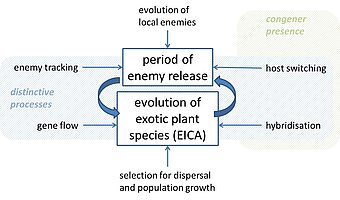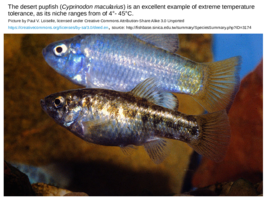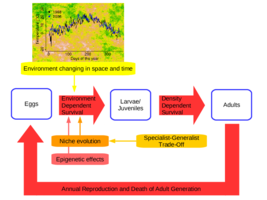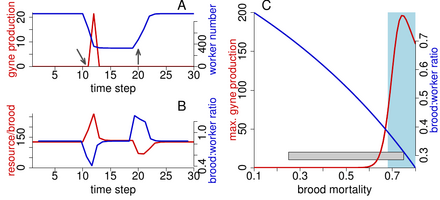Projects
The dynamics of plant invasiveness
Invasive species have a major impact on biodiversity, economies and human health, due to their effects on their novel environments. An invasive species is a species that is expanding its range after an introduction by human activity into a region out of its original distribution. In contrast, the many species that are currently shifting their native ranges in response to climate change generally cause much less environmental disruption. While both ‘invaders’ and ‘range expanders’ are subjected to very similar selection pressures during the colonisation process, there are marked differences between them. Here we pose that further investigation of these differences holds the key to explaining the relative success of invasive plant species.
One important difference is the period of enemy release. Invaders often escape from their coevolved specialist herbivores and pathogens, while range expanders are predicted to be tracked by theirs, even if there are time lags. Release from specialist enemies is predicted to offer the opportunity for plant species to lower their defence levels and invest more into other traits. We know that during colonisation of a new area the selection for dispersal capacity increases, and our main hypothesis is therefore that the period of enemy release and the evolution of the plant species reinforce each other.
To investigate this we will model bi-trophic interactions (plant-antagonist) and their evolution related to the plant colonisation processes in space and time using an eco-evolutionary model. Our model will lead to a mechanistic understanding of the differences between the colonisation processes of invaders versus range expanders, and guide future empirical research leading to mitigation or adaptation in invaded ecosystems.
Involved: Marleen Cobben, Thomas Hovestadt, Financial support: AvH REF3.3-NLD-1189416-HFST-P Cooperations: Wim van der Putten, Jeff Harvey, Arjen Biere @NIOO-KNAW
Rules for optimal timing
Possibly no single other attribute defines fitness as much as doing the right thing in the right moment. But how can organism know the right time – and what if they simply cannot know it exactly? In an ongoing SFB project we are cooperating with our SFB partners to solve just such questions.
Limited season length, unpredictable habitat heterogeneity, and avoidance of competition with conspecifics should shape the optimal timing of traits like individual spring emergence or onset of sexual production in social insect colonies. In addition to ultimate evolutionary mechanisms we also investigate the proximate triggers of behavioral transition based on long term climate data and extensive data from lab experiments.
Involved: Oliver Mitesser, Thomas Hovestadt, Hans Joachim Poethke. Financial support: SFB 1047 “Insect Timing”. Cooperations: SFB partners, Tobias Degen
The impact of artificial light at night (ALAN) on the flight behavior of moths
Nocturnal ecosystems experience a new form of pollution since an evolutionarily very short time: light pollution, caused by too much artificial light at night. Moths are the most important nocturnal pollinators and understanding fundamental behavioral patterns as well as the impact of ALAN on these seems rather important since there is evidence for a decline in their abundance and distribution. In this project, we aim to investigate related questions by combining field and laboratory experiments with a special focus on the importance of the moon for their orientation and the effect of different light spectra.
Involved: Jacqueline Degen, Mona Storms, Tobias Degen, Oliver Mitesser, Thomas Hovestadt
Financial support: DFG DE2869/1-1, PhD scholarship DBU
Cooperations: Franz Hölker, Andreas Jechow, Thomas Walter, Anna Stöckl, Keram Pfeiffer
Niche width, adaptation, dispersal and emerging patterns in spatially and temporally heterogeneous landscapes
In many environments, populations face unpredictably varying habitat conditions. To thrive in the long run, they have to cope with such variation by e.g. dispersing, bet hedging, or widening their ecological niche. Further, with a systematic trend in habitat attributes (e.g. climate change) selection on niche optima and even the mutation rate itself may also be relevant.
In this theory-orientated project we focus on understanding how landscape attributes and patterns of environmental variance and change affect the balance between these alternative strategies to cope with environmental variability and change. We include epigenetic effects into our models to further the understanding of the interrelations of epigenetic effects and evolution. We explore the dynamics of the (equilibrium) trait distributions into which the systems settles before, during and after periods of environmental change. In particular, we evaluate how landscape attributes shift the importance of the different adaptive responses to environmental variance and change.
Involved: Charlotte Sieger, Thomas Hovestadt, Marleen Cobben, Juliano Cabral. Financial support: DFG KU 3384-1/1.
Cooperation and interaction in social insects
Social insects dominate many animal communities around the world – and they provide an exciting template to understand the evolution of cooperation and sociality. With our cooperating partners we develop theories to understand the evolution of social ineractions and sociality in its early stages (‘primitive’ social insects) and to explain various aspects of life-history evolution and resource allocation in annual and perenneial eusocial insects.
Due to their tremendeous success colonies provide concentrations of attractive resources and are thus aluable targets for a multitude of other species. For years we are interested in understanding the rules of interaction and coevolution going on in such systems, especially in the famous Maculiunea-Myrmica (butterfly-ant) or between Microdon hoverflies and the Formica host ants.
Involved: Thomas Hovestadt, Oliver Mitesser, Hans Joachim Poethke. Financial support: SFB 1047 “Insect Timing”. Cooperations: Erhard Strohm, Jeremy Thomas, Karsten Schönrogge, Emanuel Fronhofer












